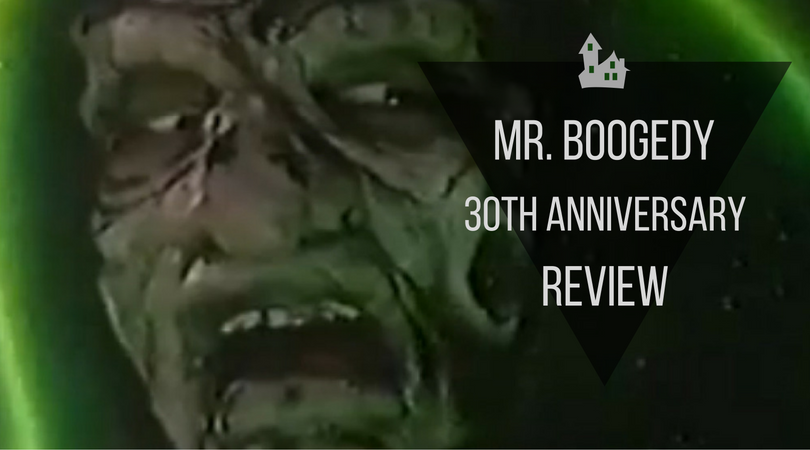
Mr. Boogedy 30th Anniversary Review
Directed by Oz Scott
Written by Michael Janover
Starring Richard Masur, Mimi Kennedy, Benji Gregory, John Astin
Happy Halloween! The arrival of the final day of October means we have officially finished 31 Spooky Nights. It was a remarkably rewarding experience, and I now have a much better grasp on what makes a horror movie work than I ever did before. Coincidentally, 2016 is also the 30th anniversary of a horror movie almost nobody remembers. But I do. I remember it all too well. And I’m ready. It’s time to watch Mr. Boogedy.
I feel the need to start off this review with an apology to my mother, because Mr. Boogedy was a source of many childhood nightmares which I see now were completely unwarranted. You see, Mr. Boogedy was produced as an episode of The Disney Sunday Movie, an anthology series hosted by Michael Eisner, in 1986. That’s right. Mr. Boogedy was a family film. A comedy. Though I do think it contains structural elements of genuine horror within it, this is not a scary movie. Mom, I’m sorry. I don’t know what I was thinking and I can only apologise now for making you check the end of my bed so many times.
Because of my history, however, I assure you I am going to take this movie 100% seriously. This is the horror film that scarred me as a child and I want to know why. This is my Nightmare on Elm Street. My Jaws. And I am so f***ing embarrassed by that you have no idea.
Welcome to Lucifer Falls

When it comes to actually sitting down and watching Mr. Boogedy, you have a few options to choose from. While DVDs of the film are rare, there are multiple versions of the film available for streaming online. The bootleg version keeps Eisner’s The Disney Sunday Movie bookends intact, as well as the original commercial breaks which include the best (and only) commercial for stamp collecting I’ve ever seen. For legal reasons, however, I can only recommend Disney’s own official 45-minute cut of the movie for online rental. The video and audio quality is far superior, it costs less than a damn fine cup of coffee, and best of all you don’t have to feel bad about Disney suing me for writing this article.
The 45-minute cut of Mr. Boogedy opens on the Davis family as they drive towards their new home of Lucifer Falls, New England. From the outset, our focus is on Carleton Davis, a gag salesman, business owner, and father. You can tell by the Groucho Marx glasses on his face as he lounges in the grass that he’s a mature and responsible adult. He’s joined by sullen teenage daughter Jennifer, a girl completely not entertained by her father’s antics. Her apathy is contrasted by the two boys Aurie and Corwin, spitting images of their father you can identify easily by their matching jackets and glasses. The family is rounded out by Eloise, a woman I can only describe as the mom from Dharma & Greg because I recognize Mimi Kennedy when I see her.
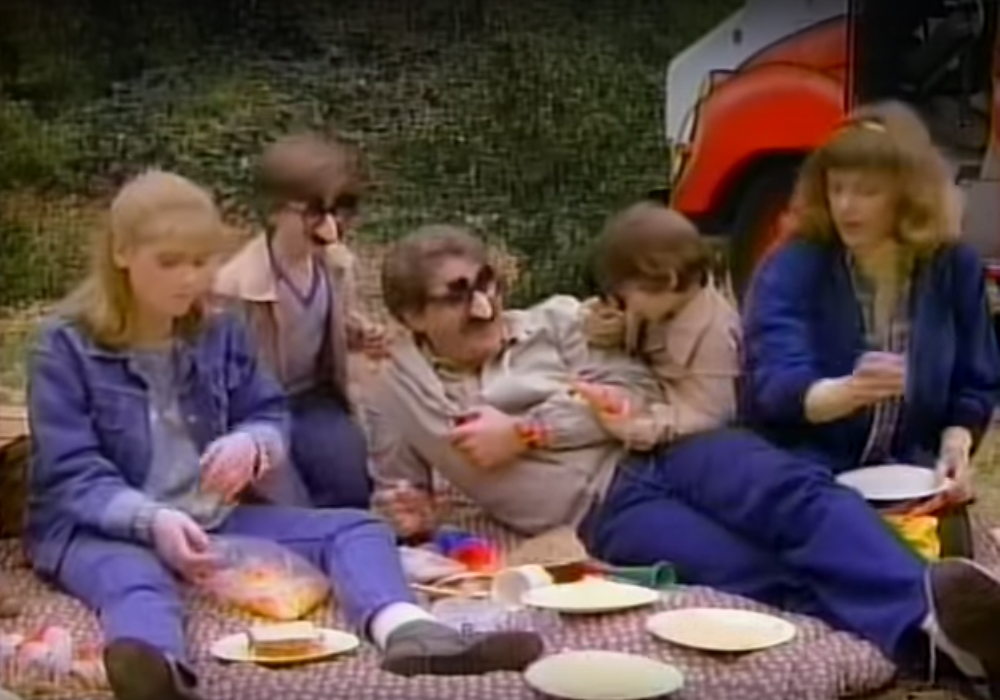
As the family enjoys their picnic lunch, it’s clear that with such an idyllic start to the story in Mr. Boogedy, this isn’t going to end well, though I hopefully don’t need to explain why any town named “Lucifer Falls” is one you should try to avoid. Carleton essentially seals his own fate at this point by stating “this is not only gonna be the perfect town, it’s gonna be the perfect house!” He says this irony-filled line immediately before the filmmakers reveal this:

Perfect? Of course! No, how can you tell? “C.B. Karloff, Realtor” is a lovely little reference that tells me exactly what I’m in for. It’s clearly a haunted house, but one that acknowledges horror movies in a way broad enough to ensure no real danger will be had. As if to drive this point home, the glowing sign of NOT REALLY HAUNTED is spotlighted soon after. Mr. Boogedy is going to be a film that embraces the trappings of horror while not actually making me scared at all. Sort of like The Addams Family. But if only there were some way to be sure…

Oh thank God. It’s John Astin! Yes, the original Gomez Addams himself is here to save the film. I let out a small sigh of relief when I remembered he was in this. His performance, nay, his sheer presence, makes any movie instantly watchable. I mean, look at that visual design! The moustache and eyebrows are admittedly a bit much, but the top hat and cape are great. In his first appearance, silhouetted against the window, he looks like The Babadook. His character has absolutely no legal reason to be in the house, but he’s there anyways to warn the Davis about what fate awaits them. Before he disappears, he leaves the family with the ominous warning of “Boogedy Boogedy Boo!”
This line holds enormous meaning for me in a way I can’t fully describe in text. When I was younger, my dad yelled “Boogedy Boogedy Boo” ALL. THE. TIME. It was his party anthem and I still hear it in his big, bearded, booming voice whenever I watch this film. I love my dad. This is a good memory. Just to be clear. Whether his call was in reference to Mr. Boogedy or not, I’ll never know. I mean, I could ask him I guess, but I probably won’t.
The Realm of Actual Horror
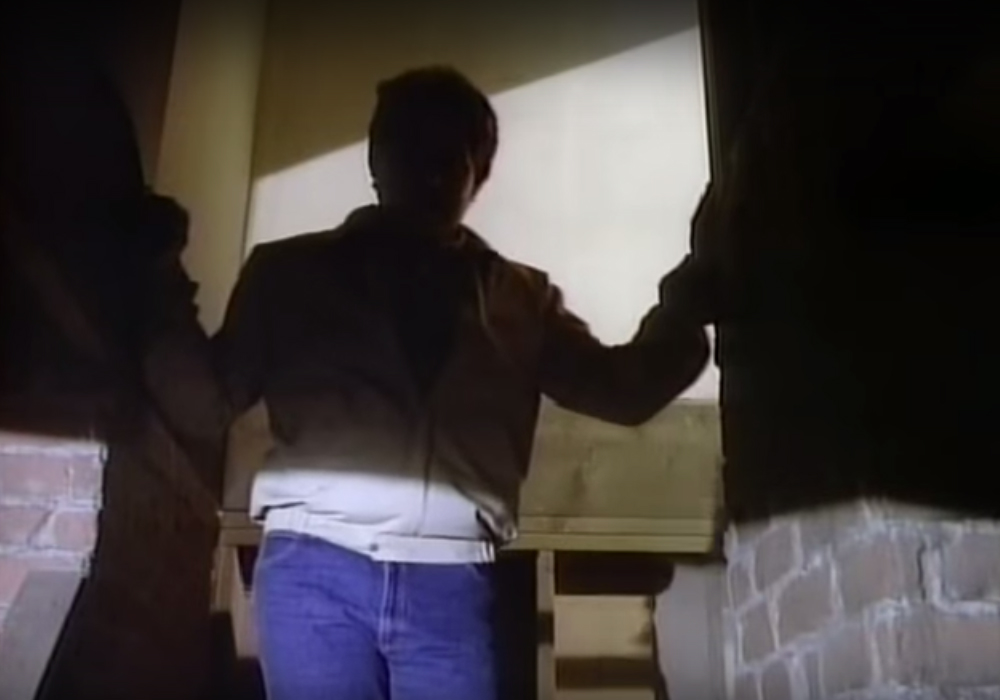
Okay, so we’re in the house now and the kids are left to explore. But a funny thing happens when the boys venture into the basement. We’re suddenly reminded that this is supposed to be a horror movie. The basement scene unsettles the viewer with shaky POV shots that imply the boys are being watched from behind the dusty shelves. Even the music takes on a more ominous quality. No longer content to parody the trappings of horror, Mr. Boogedy is now living inside the genre. Although clearly still safe, Oz Scott knows when to take these moments to ensure this isn’t a movie entirely without teeth. I genuinely perked up in this scene because of the way it was shot, lit, and staged to evoke so much actual horror of horror movies of the time. This is the sort of scene where the kids are supposed to find a mystical totem. Instead, something goes missing. Aurie’s Teddy Bear mysteriously disappears is one of many clues that not everything in idyllic Lucifer Falls is as it seems. Carleton appears at the top of the stairs to call his sons up for bed and… wait, why can’t we see his face? There’s a presence in this scene that’s just overwhelms any sense of comedy that the film is going for and makes it dark. I love it to shreds.
Then comes breakfast. And, man, this dad is just… way too into gags. As a kid, I thought he was hilarious. Also predictably, the sons are way into it. Aurie’s “eat the eggs!” line is a solid line delivery of childhood abandon in enthusiasm. Jennifer behaves exactly as you would expect any teenage girl to react to something like plastic eggs at the breakfast table. Carleton is a father unwilling to see his daughter grow up because he never has. He’s still trying to reach out to her in ways she’s outgrown, ways that still clearly work with the younger boys. Eloise, like Jennifer, sees through the act and goes through the motions with a despondent sigh. Female endurance of male whimsy will become an important theme of the film later on, which I can’t believe I’m saying because, let me remind you, this is a made-for-TV movie called Mr. Boogedy.

The next scene of absolute horror consists of Jennifer walking down the long hallway corridor in the dark. She’s drawn by an unknown force towards a green light streaming in through the door at the end of the hall. Here she becomes Nancy Thompson, Kirsty Cotton, Laurie Strode. If this were a darker film, you’d be convinced Jennifer would be the final girl standing by the end of the film. Like the basement, the scene is shot with a provocative eye for what’s naturally unsettling. This room is portrayed as the Disney equivalent of the attic from Hellraiser. No context is given as to why we should feel that way, but the cinematography of this sequence speaks volumes of unwritten text.
It was here I started considering the genesis of this movie. Is there a direct line of parody? If so, what is this ripping off? Poltergeist? It seems the closest fit, with a family unit up against a darker force and scenes like the moving toaster in the kitchen support that, but there’s too much of a named presence for that to be it either. Regardless, Jennifer blacks out after reaching the door and is woken up by her mother.

After hearing Jennifer’s explanation, Eloise’s reaction is a casual “Oh that is strange”, beginning a series of scenes in which Mimi Kennedy plays her character as if she’s met with a mild annoyance instead of the physical manifestation of the undead. Her role as “mother” trumps any other feeling the character may have, I suppose, cursing her to a portrayal that’s eternally comforting and tender. The market of this film is definitely children, with a clear message that mom will be here to tuck you back in if you get too scared. Dad’s just a useless prankster. Sigh, gender norms.
There is one thing really holding this movie back. It’s hard to hear “the Boogedy Man” seriously as a name. As soon as anybody says it, I’m taken back out of the film to remember how silly this all is. Although I imagine that’s purposeful as well. Keep the kids laughing, and they won’t be calling out for their parents in the middle of the night. At least that was the plan, right? Although starting strong, the residue of Boogedy is decidedly weak. The way Carleton takes the footprints off the wall and sticks them all over himself reflects this. He’s a gag man who only sees the comedic potential in this event that’s clearly traumatized his daughter. Great dad. Dad of the year.
The Story in a Pop-Up Book
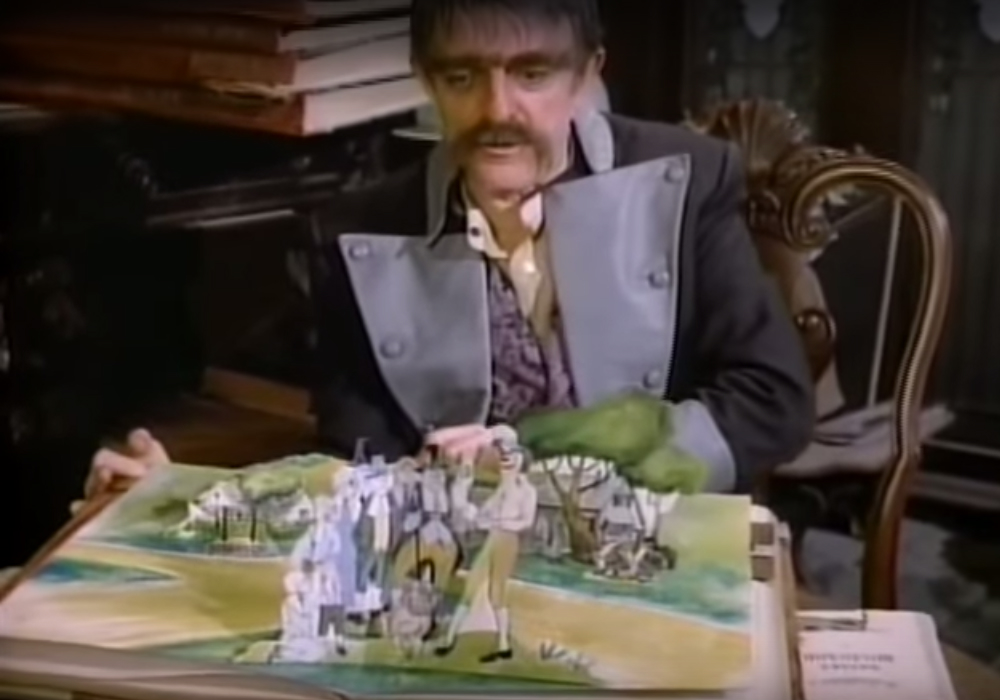
At this point, the kids are all on board that the house is haunted. Awesome. A kids against adults story. In these kinds of stories, the seemingly least trustworthy adult is the one you definitely need to turn to. Luckily, this means we get more John Astin, and that’s always entertaining. We see him again at the historical society. He asks the kids why they’re there. They ask him why he’s there. He tells the story of Mr. Boogedy and, really only by virtue of being narrated by John Astin, it’s the most entertaining portion of the movie.
Astin tells the story of their haunted house through a scary pop up book. I’m laughing because after my earlier reference about John Astin’s hat, it’s The Babadook all over again. This sequence always felt odd to me as a kid because of how “fictionalised” it is. The pop up book is dramatised through live action actors on foggy white two-dimensional sets. It feels like a play within a movie and was clearly a budget move.
It’s also odd because it’s filled with pilgrims. We usually associate pilgrims with Thanksgiving. It’s oddly rare to see them associated in Halloween, or I suppose just general horror in this context, since the original airdate of the tv-movie is April 20, 1986. Astin tells us the tale of William Hannover, a cruel and strange man who delighted in scaring children. He fell in love with the Widow Marian, mother of a sickly boy named Jonathan. Marian wants to give Hannover a chance, but he’s literally scaring children for fun. Like, girl, sometimes it’s okay to turn them down flat. She rightfully rejects his marriage proposal. And so, he LITERALLY SELLS HIS SOUL TO THE DEVIL for a magic cloak.
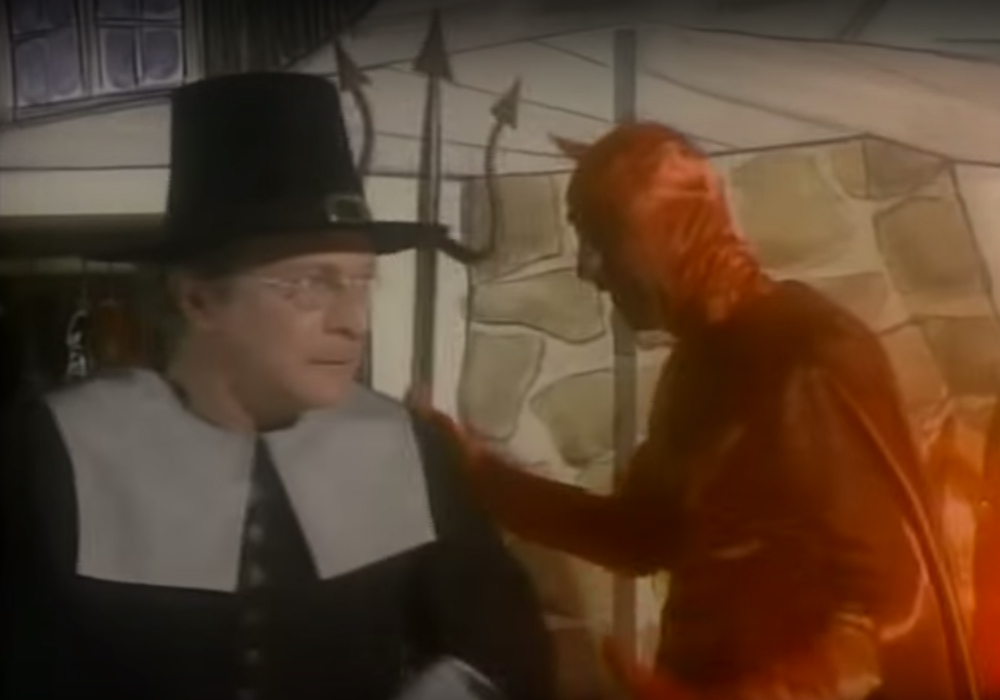
I want you to consider this for a moment because it’s a PRETTY BIG reveal. This is a Disney film where A) The Devil is real B) He is casually inserted into the narrative as an element of everyday life.
I have way too many questions about this. The only other Faustian bargain I can bring to mind in the Disney canon is Jafar asking to be turned into a genie in Aladdin. It’s not the darkest depiction of the devil mind you, but it’s still Satan! In child-appropriate TV. WHAT? I have a sneaking suspicion that if you haven’t seen Mr. Boogedy on TV in a few years, this little plot point might have a lot to do with that. Thanks, Concerned Mothers of America.
The best part of this sequence is that Astin seems to be making up the story as he goes along. I wouldn’t mind if he was, to be honest. If I got John Astin in a room I’d let him tell me whatever story he wanted and make a movie based around that. Hannover blew up his own house? Sure! They became ghosts? Yeah, I guess! Jonathan still has his cold. Umm… sure! At the end, the kids ask him what he would do if he were in their position. He responds with the most honesty I’ve seen from a character in a horror film. “I’d move!”
Are You My Mummy?
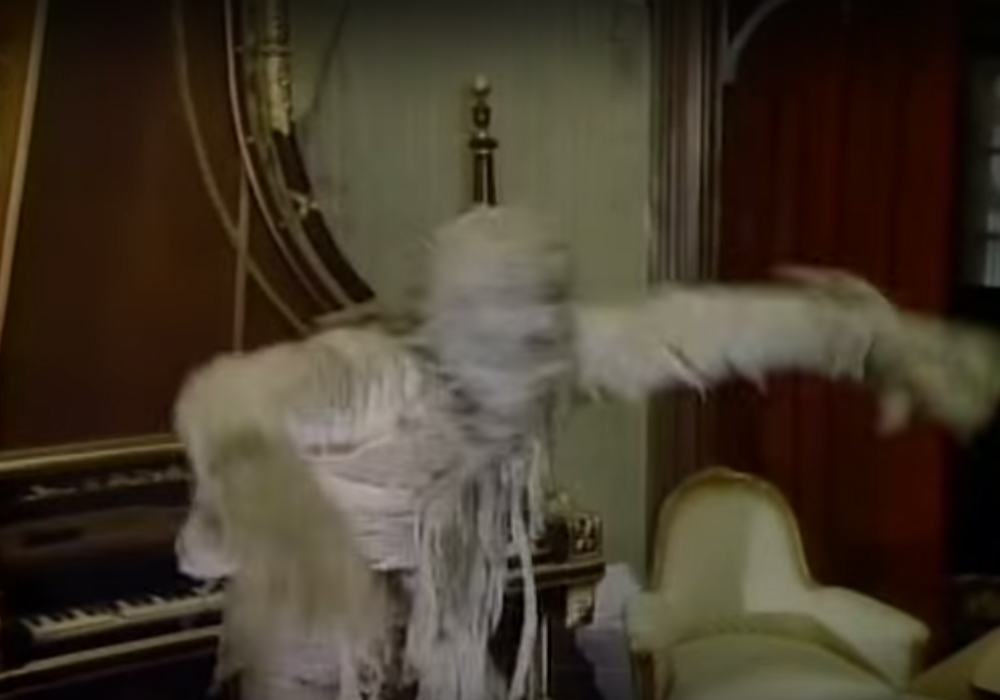
Returning home, Carleton is dismayed that the kids aren’t scared of his Dr. Zaius mask. Even the boys, who once followed their father blindly, have none of it. They’ve seen the face of the Devil, dad. Your gags don’t cut it anymore. But Carleton is still obsessed with his lame gags even after everyone else has bored with them. He shows them off in a “Mimi Kennedy laughing politely” sequence that would baffle me if it wasn’t constructed so clearly as a set up to this Oscar-worthy dancing-Mummy scene seen above. The Mummy dances with such energy, such grace. I won’t waste time trying to describe it. This is the scene where Eloise announces that it’s “time to call a realtor” but Carleton won’t let the safety of his family boss him around. He instead calls for the whole family to sleep together in the living room in front of the fireplace.
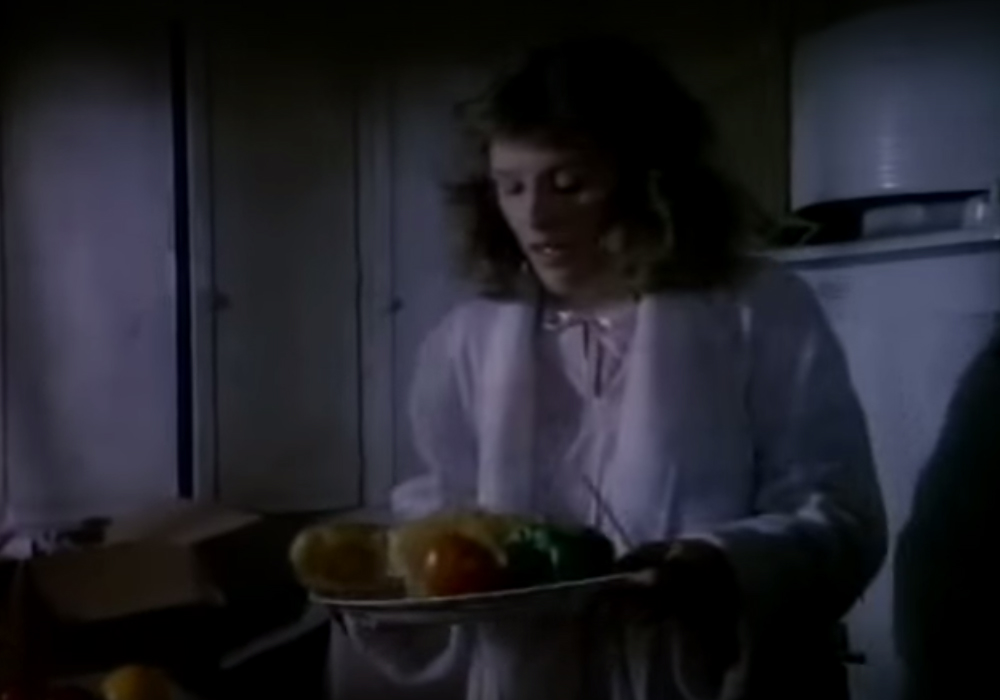
I may not have taken a warm liking to Eloise before, but this scene in the movie? It sold me on her. This mom rocks the midnight plate of cheese. I’ve been known to get up and have some cheese in the middle of the night before, but this mom simply does it up with all sorts of specialty flavours. Is that bree? I think it’s bree. And then cheese-mom meets ghost-mom in an encounter that’s actually really sweet. The widow appears to Eloise who, again, is way too casual, but we get a real sense of the Widow Marian’s pain of being separated from her son for 300 years.

From Eloise meeting Marian we clearly have to go to the boys encountering Jonathan, right? Well, yeah. And Aurie? This kid is a baller. He see him straight up wrestling Johnathan, like, getting into a full contact fight with a ghost over his Teddy Bear. This is insane because in this universe, ghosts are… electrical. We see shortly after they get up that even touching a ghost results in a strong electric shock “like one of dad’s joy buzzers”. And he’s just jumping on his back like it’s nothing. Jonathan’s just been lonely for a friend. Still though, that’s Aurie’s Teddy Bear. Give it back.
So far, each member of the family has encountered a version of the haunting that meets them on their own terms. Eloise as a mother. The two boys as innocent victims. Jennifer as an object of implied sexual desire. The only member of the family who hasn’t been convinced, remaining staunchly skeptical of all this is Carleton Davis himself. In order to progress the story, the next logical step is to meet Boogedy face-to-face, patriarchal figure to patriarchal figure.
The Manifestation of Mr. Boogedy

GAAH!! Sorry. For a moment I was five years old again cowering under my bedsheets. I think I’ve discovered why I was so afraid of this film as a child. It has nothing to do with the lighthearted film and everything to do with that lightness as a context JARRING against the shocking reveal of Mr. Boogedy himself. The decimated and decayed design of Mr. Boogedy is truly something scarring. It’s tonally at odds with EVERYTHING in this film. I was unprepared for it. We saw William Hannover before, and prepared ourselves for the solemn threat of a pilgrim man. The burns, welts, and grey skin of this monster is horrifying. Shift the colour balance a bit more towards the red side and you have an image that’s on par with Freddy Krueger.
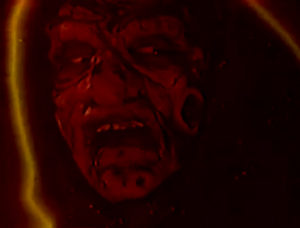
You can understand how this was a face I was terrified would be staring back at me from the end of my bed.
Unfortunately, this whole climax is criminally underwhelming. For as terrifying as Mr. Boogedy looks, and how much his power has been built up in this figure by the story so far, he just doesn’t actually do anything all that scary. The dad is stuck on a ladder. If the budget had permitted, maybe we could have seen the subjective hellscape of his mind, an endless ladder he’s forced to climb, never reaching his son. Instead, we get an actor perpetually climbing the first step like he’s in a Cindy Crawford video. Jennifer and Mom don’t even get a symbolic torture. They get wind. Although I do love the fact that the two women have to endure an endless gust of hot air from a man.
Luckily, the kid from ALF saves the day.
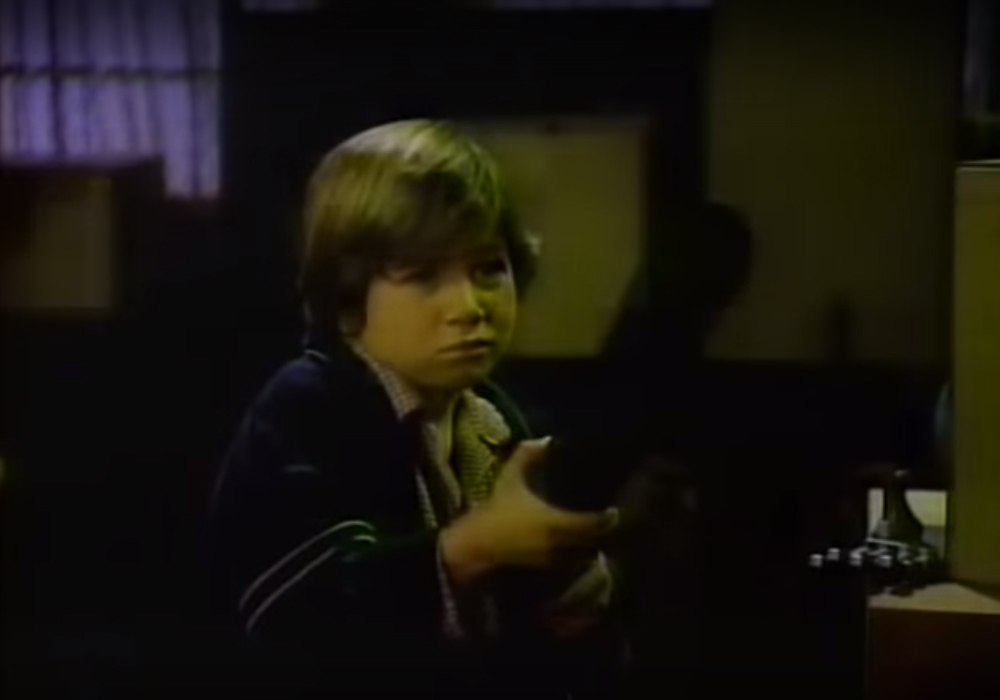
Losing his magic cloak in a vacuum is a pretty sucker’s way to go out. Even more so because of how late in the film this vacuum was introduced. It’s decidedly not Chekhov’s gun if you only see it a scene or two before it’s used. Another fundamental flaw in the pacing of this story.
Mr. Davis ends the conversation by stating “as we all know, there’s no such thing as ghosts” and I just have to ask… what the heck does he think just happened? Where did your handkerchief go, dude, if not into the pocket of a pilgrim-era child? Who was decaying gentleman you just spent an unpleasant afternoon with? A Sith Lord? The Master? We hear Boogedy’s laugh coming from the vacuum and Carleton’s eyes bulge in an expression that might as well flat out say “THE END?”
If you’re watching the The Disney Sunday Movie cut of the film, this is where Michael Eisner returns to safely inform you that next week’s offering will be 1973’s Robin Hood. Nothing could feel softer or gentler by comparison, an assurance that everything is okay and that we can walk away from this film unscarred. It didn’t work, Michael Eisner! I still had nightmares! And I LOVE Robin Hood, but don’t think you can buy me off!
(Sidenote to Disney, you can totally buy me off. I still don’t own Robin Hood on Blu-Ray.)
Final Boogedy Notes
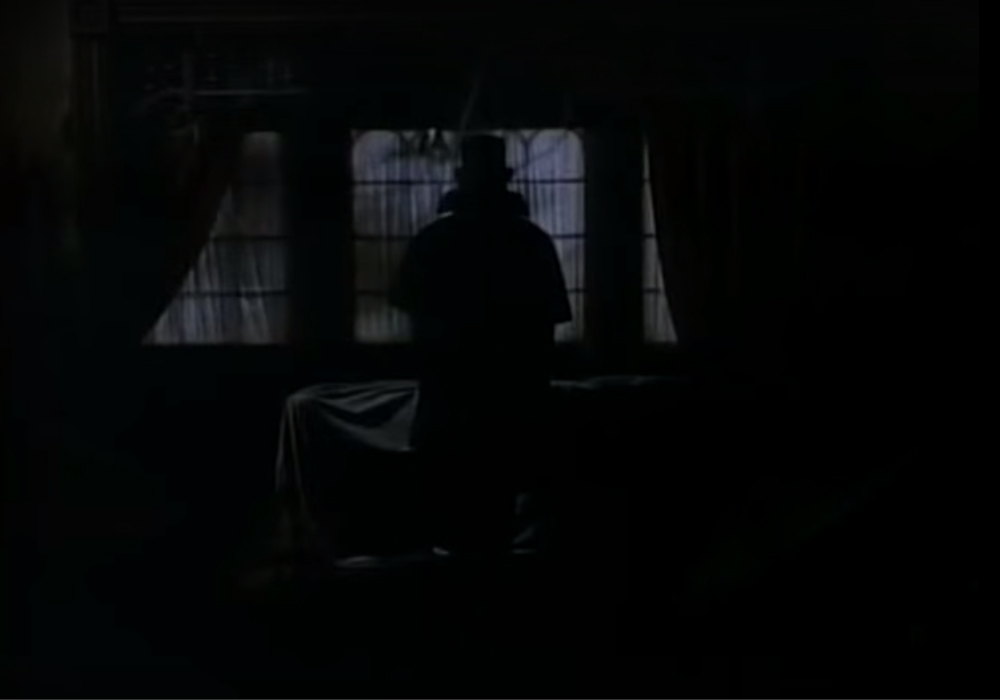
After holding onto the nostalgia of this movie for years, I finally did some actual freaking research on it for the context of this review. The original script apparently went through several drafts, the first being shopped over at Columbia Pictures instead of Disney. At one point an Airplane!-esque spoof, another a Cheech & Chong vehicle. Both have their appeal, and I can honestly see the motivation for an Airplane!-esque cut of this film that focuses more on Carleton being a special-effects and gag guru to actually deconstruct the horror narrative would be smart. It’s an angle that would be taken seriously in Wes Craven’s New Nightmare and Scream and less seriously in Scary Movie.
As it stands, Mr. Boogedy remains a perfect example of what a “spooky” movie can be. You are 100% safe watching this one with your kids. It uses horror tropes to create the illusion of a scary movie without ever actually being scary itself. It has the benefit of bringing up some dark ideas, but never actually going anywhere with them. It is also graciously only 45 minutes long without commercials, meaning that any bad idea is easily done and dealt with before it can overstay its welcome.
If you enjoyed my take on this horror classic, you may be interested to know I recently enjoyed 31 Spooky Nights alongside my Scooby Dos or Scooby Don’ts co-host Amelia Wellman. We watched everything from Black Christmas to Friday the 13th to It Follows over the past month and it’s where I learned a lot of what I talk about here.
If you specifically enjoyed this article, be sure to let me know on Twitter at @thebillyseguire or @roguesportal. Tell me if I should do more of these articles! There are still plenty of childhood villains I have to face…


![[REVIEW] TEST #1 IS THE FUTURE OF CYBERPUNK](https://geekd-out.com/wp-content/uploads/2019/07/Test1Art2-679x1024-150x150.png)

